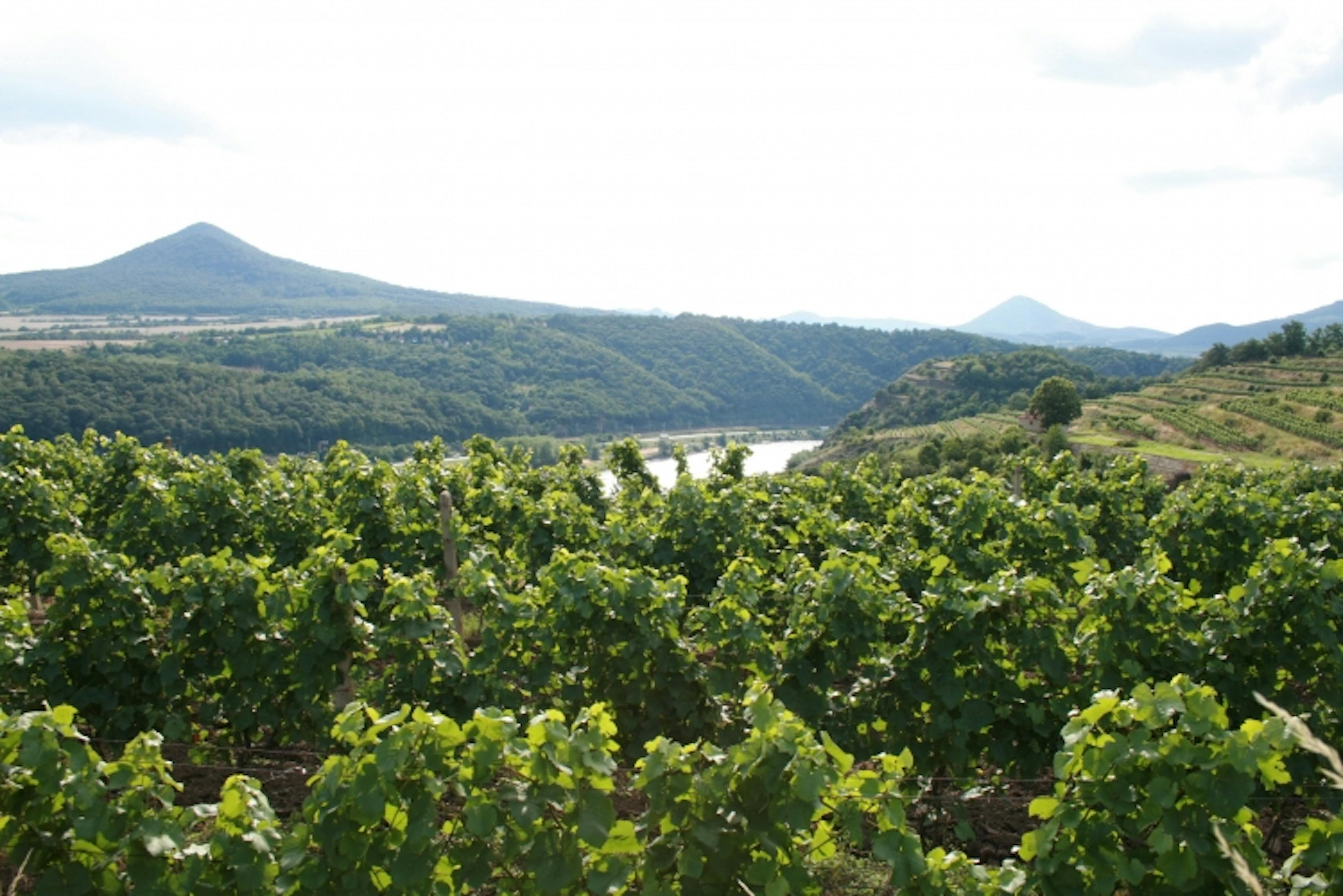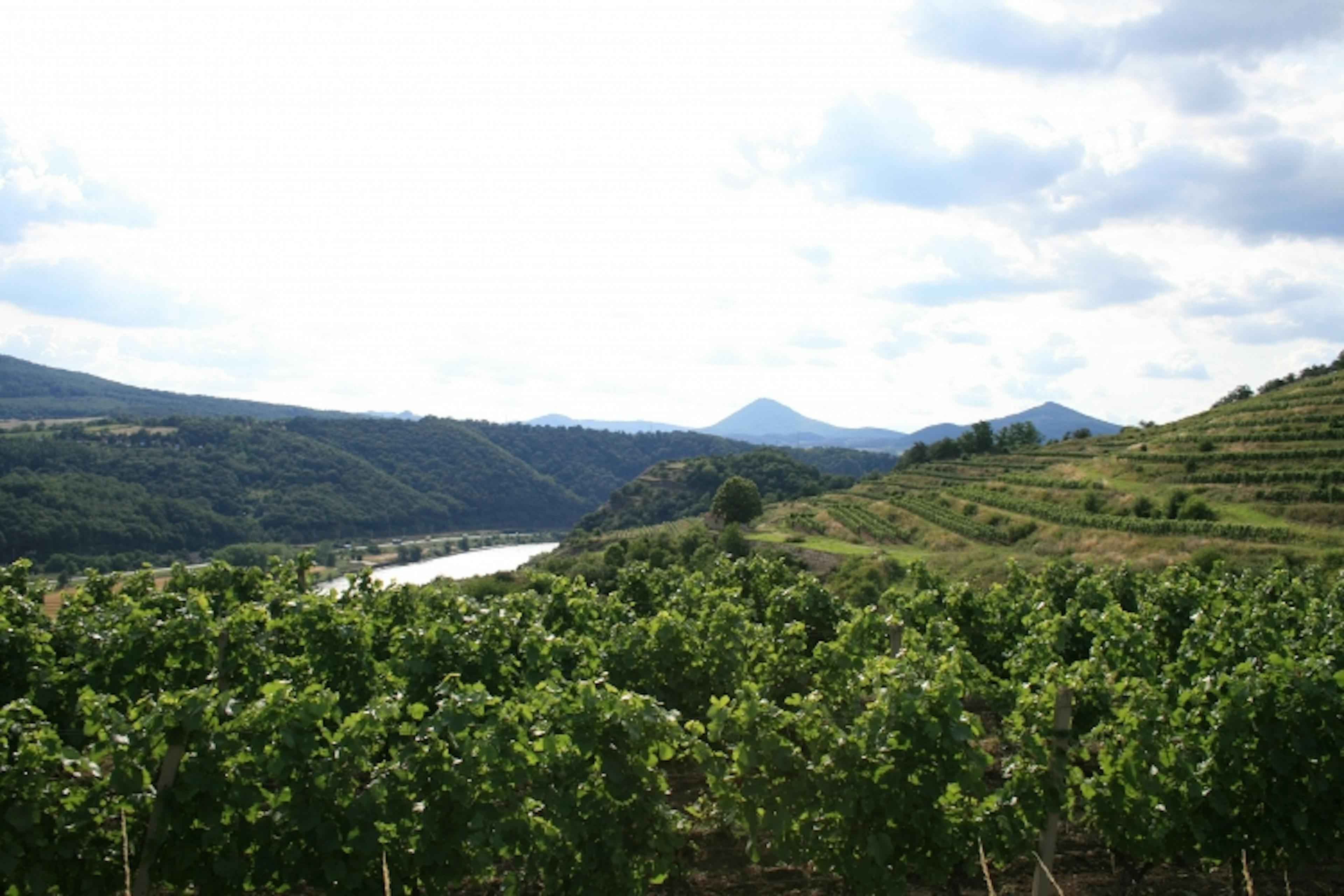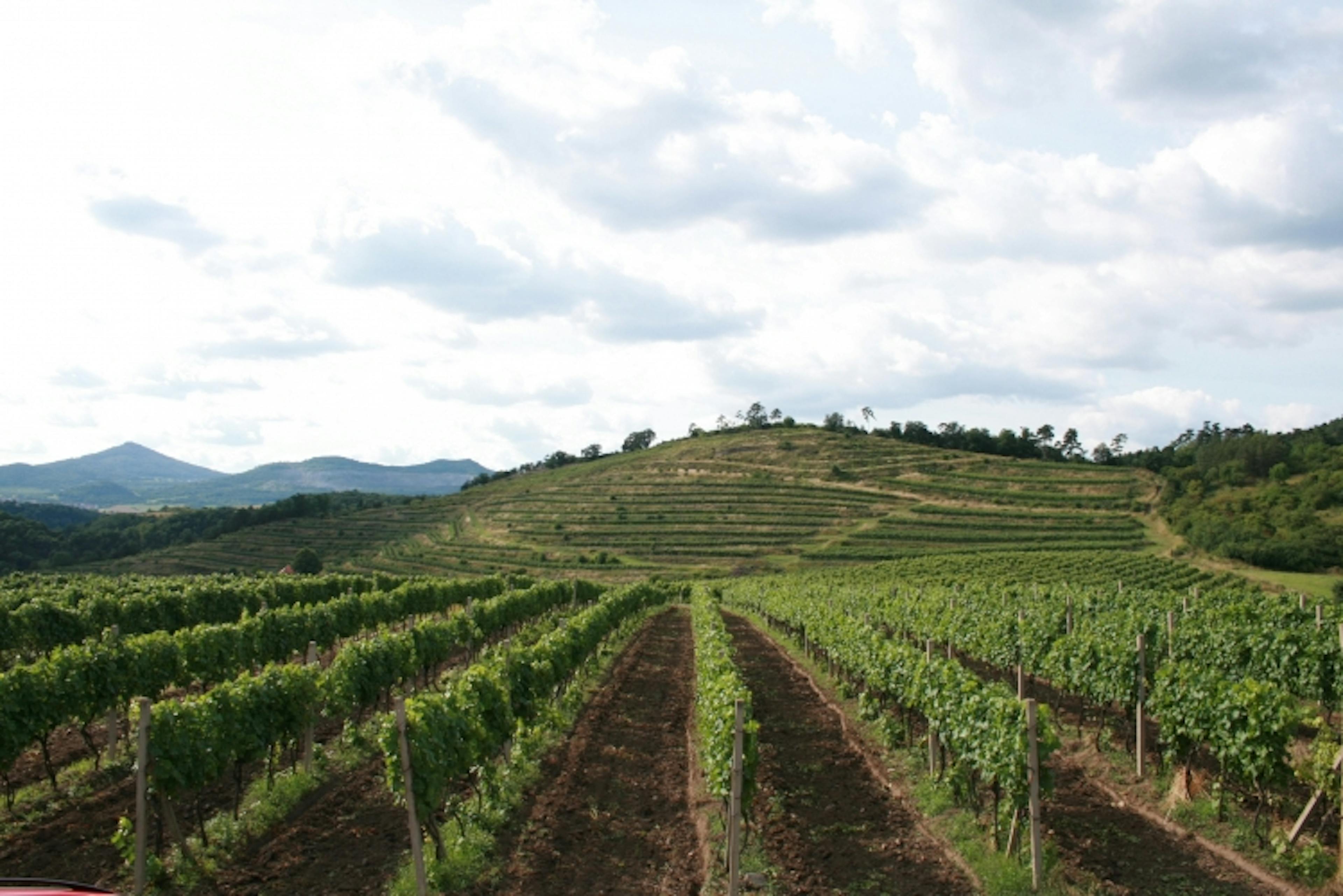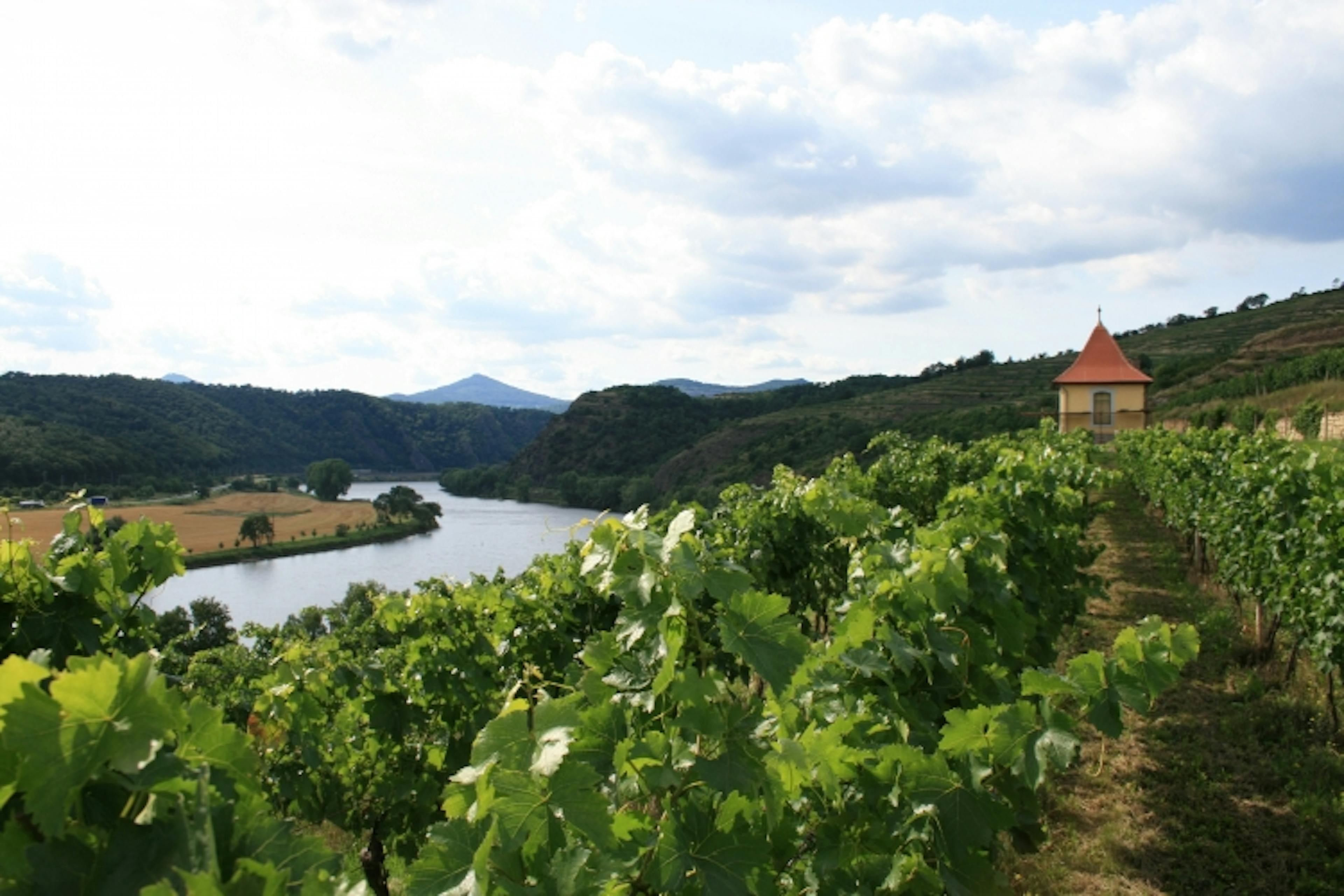Geological conditions
For the subject of geology let us briefly examine the writings off the geologist Miloš Suk (1995):
The geological composition of the Czech viticultural regions is extremely varied. Vineyards used to be concentrated, and in many cases still are, mainly in the warmest locations along the banks of the rivers Elbe, Vltava, Ohře and Berounka. Around Prague the rocky subsoil is made up of Silurian and occasionally Devonian limestone in the Prague basin and Ordovician clayey shale with volcanic ingredients as well as chalky deposits. Silurian limestone is usually very pure, with silicate impurities of up to 10%; not even dolomites exceed this percentage. The trace-element content in this type of limestone leans mostly towards barium, strontium and manganese. To the north of Prague the sedimentary rock of the chalk basin is known as argillite. Paleozoic rocks in the southern part have a higher boron content. In the Proterozoic bed-rock around Troja and Roztoky the nutrient content is sufficient, and includes trace elements, mainly boron.
The geological composition of the Czech viticultural regions is extremely varied.
In the area surrounding Mělník and Roudnice the bed-rock is formed from Turonian deposits. These are mainly sandstone, marlite, loess and then Quaternary sand drifts and the gravelly sand deposits of the river bed of the Elbe. Loess has a high calcium content although it lacks phosphorous. Around the town of Litoměřice the bed-rock is made up from Turonian marlite and marly sandstone with an effusion of vulcanites, predominantly alkaline basaltoids. In the Žernoseky subsoil we find mainly phyllites and metavulcanites. Chalky deposits are rich in calcium as well as boron while being poor in zinc.
The bed-rock around Most contains a wide variety of vulcanites, loess and the Tertiary deposits of the Most basin itself. North-west of Most there are phonolites having a higher potassium content while at the same time lacking in calcium, magnesium and phosphorus. To the east and south of Most the composition is of tephrites, basanites, nephelites which contain sufficient amount of nutrients.
In Louny and Slaný the bed-rock is composed of Turonian marlite and marly sandstone, while to the north of Louny we find Tertiary clay. Generally this contains a sufficient amount of calcium and boron but it is poor in phosphorus and zinc.
In Louny and Slaný the bed-rock is composed of Turonian marlite and marly sandstone, while to the north of Louny we find Tertiary clay.
In the area surrounding Chrudim vineyards used to be planted on the Turonian marlite and sandstone of the Bohemian chalk basin. In Kutná Hora and Čáslav there is metamorphic schist and, in some places, amphibolite hornblende-schist or else the sandstone and claystone of the Bohemian chalk basin.
The Moravian wine regions lie on the boundaries of the Bohemian Massif and the western Carpathians. The westerly part, between Znojmo and Brno, lies on the edge of the very Bohemian Massif and the bed-rock is formed predominantly of granitoids of the Brno pluton and in smaller measure by the schist of its mantle. The rocks in this area are mostly eroded and caolinised. This wine district is also famous for its typical loess soil composition. The central part stretching south from the town of Brno to the state frontier is formed from the Tertiary sea deposits (predominantly sandy) of the Carpathian frontal vasin and the Viennese basin. Between both of these Tertiary basins we can find Jurassic and Paleogenic marly deposits, often of calcareous origin, of the Ždánice fold overthrust, which belongs to the flysh belt of the outer Carpathian range. From the drift map we can observe the significance of the loess and gravelly-sand of the river beds of Dyje, Svratka, Jevišovka and Morava.
This wine district is also famous for its typical loess soil composition.
Towards Znojmo from the west of the Bohemian Massif crystalline encroaches with its schistous mantle. Granitoids of the Dyje Massif are very strongly caolinised.
According to the the statements of Marie Adamová on the content of elements in the bed-rock, whose characteristics we outline below, the granitoids of the Znojmo region have a lower calcium and phosphorus content, and in some cases even contain magnesium. In the light granite there is little zinc while the Miocene clay and gravel contain little calcium, magnesium, phosphorus and zinc.
In the Mikulov region we have cliffs, such as those of the Pálava hills, of Jurassic limestone with, in places, sandy limestone and dark marl. The cliffs are surrounded by deposits from the Cretaceous period, to which pertain clay and claystone, usually of argillo-calcite. In the western edge Tertiary sandstone and loam are widespread though the clays of the Carpathian frontal basin are lacking phosphorus but have a high boron content. Loess east of Mikulov generally has a sufficient measure of nutrients except for phosphorus, although the amount of boron is excessive. The cliffs are rich in calcium, but the potassium content is insuficient as is often the case with phosphorus and magnesium.
In the Mikulov region we have cliffs, such as those of the Pálava hills, of Jurassic limestone with, in places, sandy limestone and dark marl.
The Brno region has a similar geological composition to that of Znojmo. South of Dolní Kounice the granitoids of the Brno Massif are immersed in deposits of the Carpathian frontal basin. Granitoids are poor in magnesium, phosphorus as well as calcium. The metabasites lack potassium, phosphorus and boron. The loess does not have enough phosphorus and the Miocene limestone loam is richly endowed with calcium.
The region of Velké Pavlovice lies at the eastern border of the sub-Silesian-Ždánice brow and the Viennese basin. The crust fracture is located between the villages of Terezín, Vrbice and Rakvice. To the west of it we find the Ždánice-Hustopeče strata which contain a wide variety of subsoils such as limestone, marly clay, argillo-calcite, heterogeneous sandstone and conglomerate etc. The content of all trace elements is typical for calcareous deposits. In the area surrounding Klobouky the soil has the designated loess content but lacks phosphorus and is over-abundant in boron.
The Mutěnice region lies on the fault line of the Viennese basin. To the north-west we find clayey limestone, clay and sand soil along with isolated Pannonian gravel. The nutrient content, with the exception of phosphorus and zinc, is sufficient. Around Čejkovice the clayey soil also contains a certain amount of carbon, whilst to the south-east there are younger versatile clay soils.
Between Bzenec and Mutěnice there are layers of clay subsoils and gravelly and sandy patches of Upper Miocene origin surrounding the town of Moravský Písek. The youngest gravel and sand originate from the Upper Pliocene period.
The region of Strážnice is situated in the foothills of the White Carpathians and the bed-rock of the vineyards
The region of Podluží lies in the central part of the Miocene Carpathian-Viennese basin where, between the towns of Břeclav and Hodonín, a variety of clay and sandy soils can be found with some gravel content. Lednice is surrounded by even older deposits. Rocks of various ages co-exist, no doubt due to movements taking place along the complicated fault line. The Hodonín area is formed of Quaternary sand drifts. The Miocene deposits are lacking in phosphorus and calcium, but they have a sufficient quantity of boron. The sand drifts are lacking in calcium, magnesium, phosphorus and zinc.
The region of Strážnice is situated in the foothills of the White Carpathians and the bed-rock of the vineyards dates back to the Eocene or Upper Cretaceous period. The vast majority of local soils is of the hard type, with water-retention ability and with clay of autochthonous origin.
Source: Réva a víno v Čechách a na Moravě
© V. Kraus a kol.
© RADIX, spol. s r.o.



